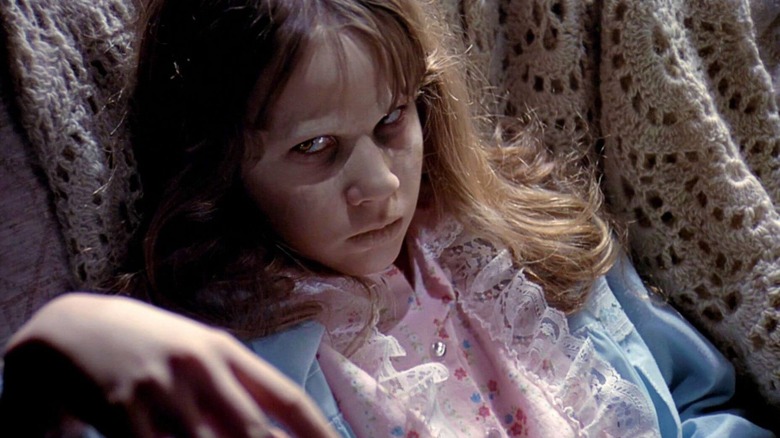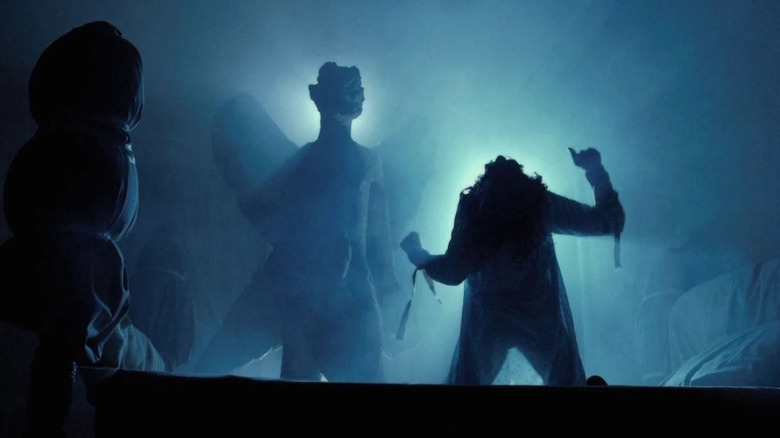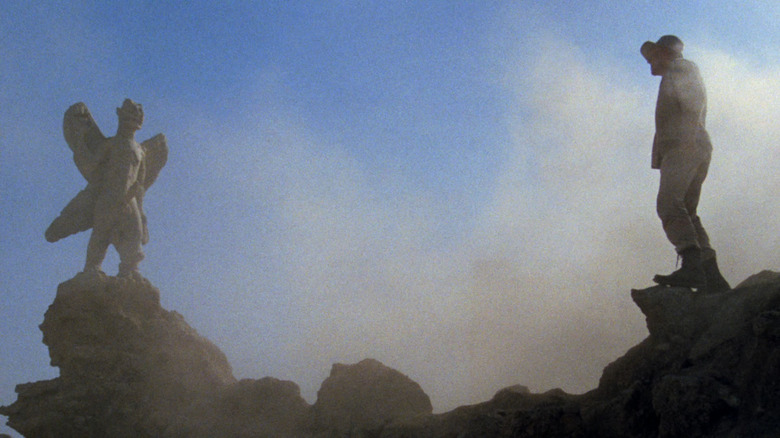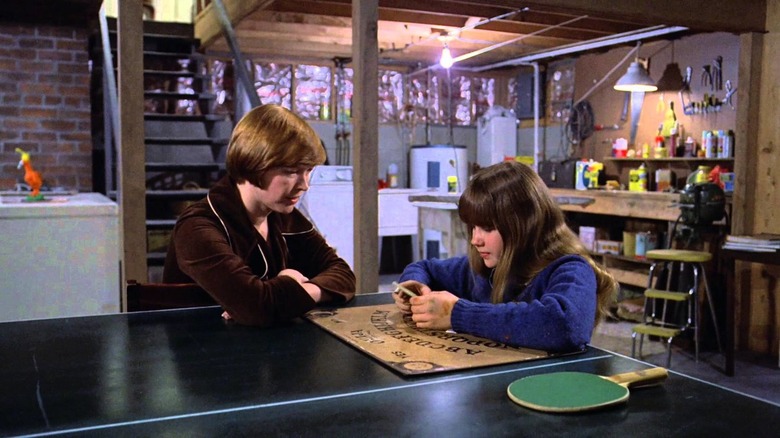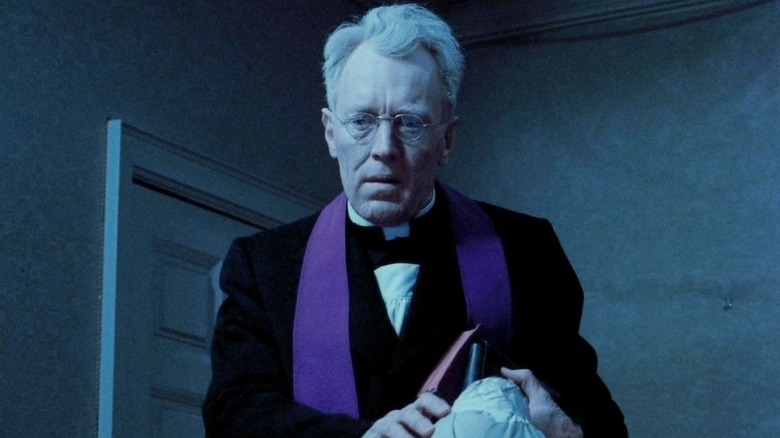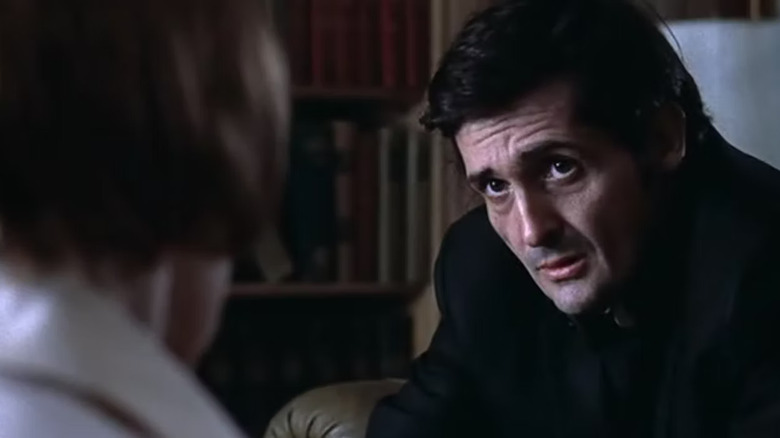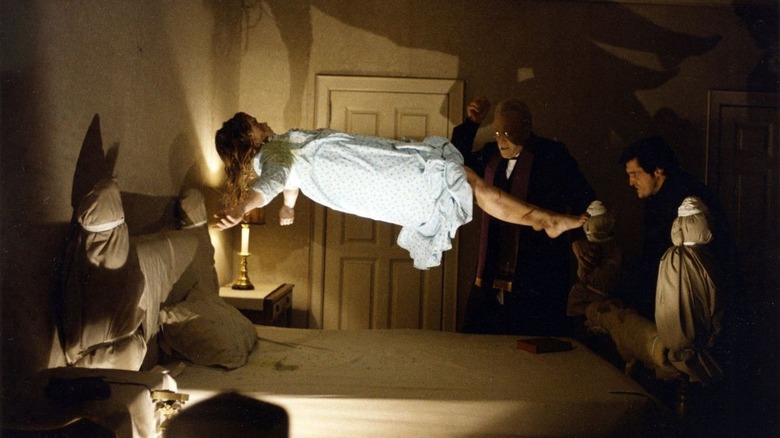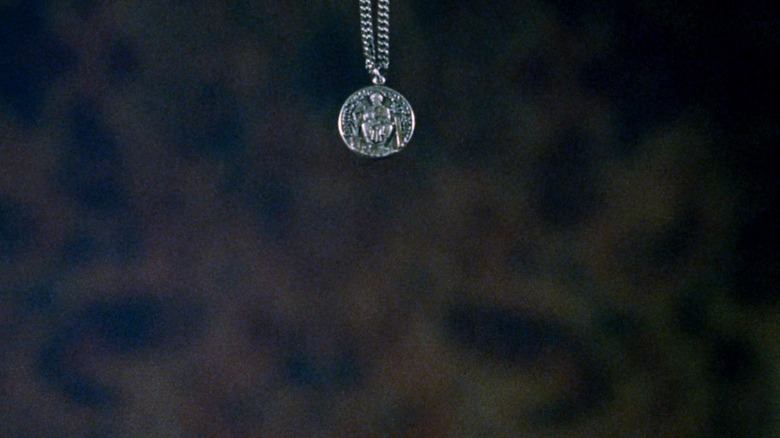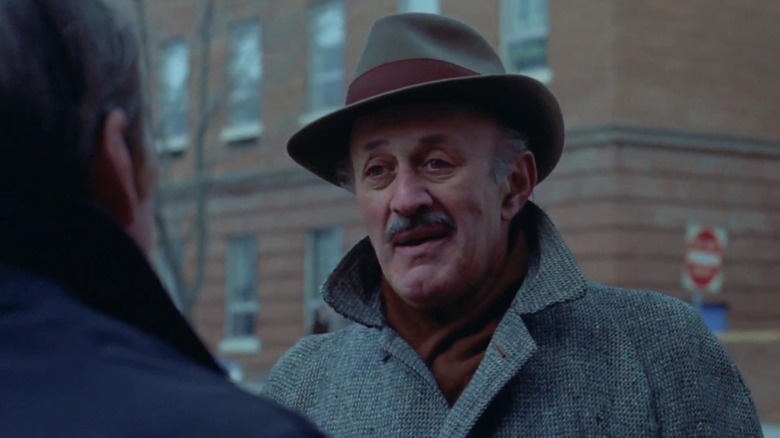The Exorcist Ending Explained: Beating The Devil
In May 2020, a former NASA engineer named Ronald Edwin Hunkeler passed away at the age of 85. During his time with the space agency, he had patented heat shields that helped put people on the moon in 1969, but he lived in constant fear that his other claim to fame would be unearthed. For during his teenage years, he was the boy who inspired "The Exorcist."
Although the case has been subject to great scrutiny and skepticism since it was reported in 1949, the "Roland Doe" exorcism remains one of the most famous possession cases, largely thanks to its relation to William Friedkin's blockbuster movie. Hunkeler, who was given pseudonyms to protect his identity, was 13 years old when the disturbances began. First, there were strange noises and moving objects. Then he started displaying increasingly unusual behavior, talking in a guttural voice unlike his own, speaking Latin phrases, and showing extreme discomfort when presented with sacred objects. He also became violent, attacking a priest with a piece of bedspring during one attempted exorcism, and words appeared scratched on his skin. In a later ritual, his bed was seen to shake and he broke another priest's nose before he was finally freed of his ailment.
Author William Peter Blatty heard the story while at university and later used it as inspiration for a novel. He switched the sex of the victim and the rest was history: First published in June 1971, "The Exorcist" was a hit, topping the New York Times bestseller list for 17 consecutive weeks (via The Guardian). Friedkin's film version came two years later and was also a controversial success, a box office smash with urban legends of audiences puking in theaters, and becoming the first horror movie to receive an Oscar nomination for Best Picture. Let's take a look at how it all plays out.
So what happens in The Exorcist again?
"The Exorcist" opens with an eerie prelude set in Northern Iraq where aging priest Father Lankester Merrin (Max von Sydow) is heading up an archaeological dig. Among the finds is a silver St. Joseph medal from a completely different time period than the other relics and a statuette head of the demon Pazuzu. The latter object shakes him and he decides he must leave, as if to attend to urgent business. He visits the site again before he departs and finds himself facing off against a life-size statue of the demon.
Next we're in Georgetown, Washington D.C., where actor Chris MacNeil (Ellen Burstyn) is starring in a film directed by her friend Burke Dennings (Jack MacGowran). While in town for the shoot, she lives in a large townhouse with her 12-year-old daughter Regan (Linda Blair), where things are going bump in the night. Also from the neighborhood is Father Damian Karras (Jason Miller), a troubled young priest who is suffering a crisis of faith due to his guilt about his elderly mother dying alone.
Regan talks about an imaginary friend called "Captain Howdy" and starts displaying unusual behavior, and her symptoms grow worse after she urinates on the floor at one of her mother's parties. Medical tests also prove fruitless as Regan becomes abusive and violent, apparently possessed by a demon. When Dennings is found dead at the bottom of a flight of steps outside her bedroom window, detective William Kinderman (Lee J. Cobb) investigates the case, asking Karras about potential suspects in the priesthood.
Confounded doctors mention exorcism as a last resort, and Chris turns to Karras to help save her daughter. Karras puts in a request to perform the rites, but his superiors decide he could use a little experienced help. They send for Father Merrin to conduct the rare ritual.
What is the demon Pazuzu?
One of the most striking shots in "The Exorcist" is Father Merrin face-to-face with an imposing statue of Pazuzu, a terrible winged demon with a dog's head and a snake-headed penis. The imagery couldn't be more clear; this is a showdown between good and evil.
Pazuzu is a Mesopotamian demon who was considered a powerful evil force, but the roles of demons were more complex in pre-Christian cultures (via World History Encyclopedia). In Mesopotamian culture, even the most destructive demons were also capable of good. We now associate the word "demon" with pure evil, but it is derived from the Greek "daimon," or spirit, which better explains their more ambivalent role. Demons only became associated with the Devil after the birth and spread of Christianity, which cast out older religions or repurposed parts for its own.
Therefore, while Pazuzu controlled destructive winds that brought famine and locusts, he could also be invoked for protection. He was thought to be especially effective in protecting pregnant women and young children from Lamashtu, a demon-goddess who preyed on babies, and was also handy for warding off disease and impotence. This is what Merrin's colleague means when he says "evil against evil."
The statue Father Merrin faces is an accurate depiction of Pazuzu, although likenesses of that size have never been found; Mesopotamians believed that creating something so large could attract the attention of the demon it represented. Smaller statuettes, like the one he finds in the hole, could harness their protective powers and were placed in the home to ward off evil spirits.
Notably, a clay model of a bird that Regan makes echoes the design of the statue. Has Captain Howdy somehow fed her that image, or has she even seen Pazuzu in his true form? Or could she just be picking up on it subconsciously?
How does Pazuzu end up possessing Regan?
"The Exorcist" doesn't make it completely clear about what is possessing Regan, which has caused a little confusion among fans. It doesn't help that the possessed Regan shouts "And I am the Devil!" by way of introduction to Father Karras, but the lore established in both the novel and subsequent films confirm that it is indeed Pazuzu. The big question is why does Pazuzu, once at large in Assyrian and Babylonian superstition, end up possessing a young girl thousands of miles away from his home turf in Washington D.C.?
With the demons cast, from a Christian perspective, as Satan's henchmen, any one of them could have possessed her. Perhaps Pazuzu, with his reputation for scaring away evil, was simply the most dominant when the right channel of communication was opened up. This is where the ouija board comes in, offering a cautionary tale against the dangers of using occult items for a bit of a lark. As Christianity.com warns:
"Christians and all people need to know that Ouija boards are not a gateway to communicating with dead loved ones. Ouija boards are direct communication with Satan and his demons only. When a person passes away, they can no longer communicate with the living (Luke 16:19-31)."
Ouija boards have been sold commercially as a game or toy since the late 19th century; Walmart online even offers a large selection. Regan says she found hers in the closet and has been using it to chat with Captain Howdy; unknown to her, the imaginary friend is Pazuzu's benign mask as he gains her trust before possessing her.
Father Merrin
Max von Sydow was only 43 when he played 80-year-old Father Merrin, undergoing three hours of makeup work each day to look the part (via The Hollywood Reporter). As always, he brings such gravitas to the role; Merrin maybe be weary and ailing, but he is just the kind of authoritative figure you'd want conducting your exorcism.
Author William Peter Blatty based the character loosely on Gerald Lankester Harding, the British archaeologist most well-known for excavating the caves where the Dead Sea Scrolls were discovered in modern-day Palestine, as well as overseeing their preservation and study. With this source of inspiration, it's fitting that we first meet Merrin on a dig, and his encounter with the Pazuzu statue takes on greater significance when we later learn that he previously conducted an exorcism in Africa that almost cost his life.
This explains the apprehension on his face when he first unearths the statuette head of the demon. While the film doesn't specify that Pazuzu was his opponent in the earlier ritual, it makes sense. Mesopotamian influence reached into Egypt and North Africa before the time of Christ, so it follows that their demons also went with them.
Merrin's death during Regan's exorcism is left a little to the viewer's imagination. We see that he is old and infirm and he pops pills whenever the stress gets too much (in the novel, he takes nitroglycerine for a heart condition), pointing to him suffering a heart attack when left alone in the room with the girl. But what triggered it? When Karras enters the room to find him dead, Regan is free of her restraints and giggling in the corner of the bed, suggesting Pazuzu said or did something that pushed the elderly priest over the edge.
Father Karras
Father Karras, brilliantly portrayed by playwright Jason Miller, is the true heart and soul of "The Exorcist." It is as much his story as Regan's, with his crisis of faith and grief at his mother's loss running parallel to the girl's deterioration under the malign influence of Pazuzu. The demon really goes hard at Karras; it's almost as if Regan is just a temporary residence until he can lure someone like the doubting priest. Pazuzu constantly tests the nerve of Karras, first mimicking an old homeless man he ignored earlier in the film before sadistically taunting him about his dead mother. "What an excellent day for an exorcism," said by Pazuzu, is one of the film's most memorable quotes, followed by a key exchange:
"You'd like that?"
"Intensely."
"But wouldn't that drive you out of Regan?"
"It would bring us together."
"You and Regan?"
"You and us."
This suggests Pazuzu has his sights set on Karras and foreshadows the end of the film, where the demon gets what he wants but not quite in the way he perhaps hoped. After the demon imitates his mother and does away with Merrin, Karras snaps and starts beating Regan, demanding that the evil spirit takes him instead. The chance to corrupt a man of the church proves too tempting for the demon to pass up; snatching away the protective medallion of St. Joseph, he makes the leap into Karras's body. Pazuzu forces him to attack Regan, but Karras summons the willpower to fight the demon back long enough to throw himself out of the window, sacrificing himself to save the girl. As his life ebbs away at the foot of the steps where Burt Dennings also died, his friend Father Dyer (Father William O'Malley) holds his hand and delivers the last rites.
Real-life exorcisms
According to some sources, exorcisms are on the rise today, with Christian outlets blaming the rise of ghost-hunting TV shows like "Most Haunted" and supernatural-themed shows on Netflix potentially having a psychological effect on susceptible viewers, especially during lockdown. If you live in the catchment area of the Archdiocese of Washington, their website even matter-of-factly outlines the process you need to go through to request an exorcism.
Premier Christianity details what happens during an exorcism, or "deliverance" in the Anglican Church, playing down the hokier elements that we are familiar with from movies like "The Exorcist" and its sequels. Apparently, the church takes great pains to discourage inexperienced exorcists from trying out the ritual, citing the unfortunate case of Annelise Michel as an example of what can go seriously awry in the wrong hands.
Michel was a young German woman suffering from mental illness who became convinced, along with her family, that she was demonically possessed. Two priests acquired permission to perform an exorcism and, 67 sessions later, she died of malnutrition and dehydration. A court trial followed where the priests and her family were found guilty of negligent manslaughter, and the case prompted calls from bishops and theologians to update the Roman Ritual of 1614, the liturgy Merrin quotes in "The Exorcist." They felt that passages addressing the Devil directly could reinforce the sufferer's belief that they were indeed possessed by a demonic force (via Washington Post). Michel's story has inspired three movies, the most high-profile being "The Exorcism of Emily Rose."
In the hints and tips that come with the ritual, it recommends identifying a phrase that has a particularly strong effect on the demon and repeat it. This is perhaps why Merrin and Karras lock onto the phrase "the power of Christ compels you" during their exorcism.
The St. Joseph Medallion
While on the dig in Iraq, Father Merrin inspects some items that have been unearthed, including a small round St. Joseph medallion — an interesting find considering it was buried on a pre-Christian site. The mystery of its provenance is never explained, but its discovery along with the Pazuzu head sets up the theme of an age-old battle between good and evil.
As a symbol of good, the medal appears as a an important motif throughout the film. When Karras has a dream sequence, we see it falling through the air, symbolizing his loss of faith and his foreshadowing fatal fall at the end of the film. Later, it appears in the exorcism scene as he struggles with Regan, who rips it from his neck and removes the protection it affords before Pazuzu enters his body. It isn't clear whether it is the same medallion from Iraq, perhaps given to him at some point by Merrin, or one like it. However, like the Pazuzu statue that briefly appears in the exorcism scene, its incongruous presence establishes the notion that good and evil know no borders.
The medallion makes its final appearance at the end of the movie, with a different slant depending which cut you watch. As they leave, Chris gives it to Father Dyer as a reminder of his deceased friend. In the theatrical cut, he accepts it and watches them drive away. In the later Extended Director's Cut, he hands it back to her saying, "I think you should keep it." Chris doesn't protest; while she is agnostic for most of the film, this indicates that she has at least become acceptant to the possibility of God by the end. It also has another connotation. Regan might be in the clear for now, but does Dyer think she'll need its protection in the future?
The beginning of a beautiful friendship
William Peter Blatty always considered "The Exorcist" a story about the triumph of good over evil, but the film's alternate endings differ in how much this comes across. His novel concluded with Detective Kinderman befriending Father Dyer as they walk away from the house, a scene that William Friedkin shot but decided to cut from the original theatrical version. Instead, he left us with Dyer looking down the steps where Karras died before walking away, closing on a far more somber note. Blatty felt that ending the film in such a way caused some viewers to believe that the Devil had won, even though Regan was saved by the sacrifice of the two priests (via Den of Geek).
In the Extended Director's Cut, Friedkin restored the scene with Kinderman and Dyer. I thought it was a bit odd when I first saw it, played in a lightly comic register that is largely absent throughout the rest of the movie. Calling back to his earlier conversation with Karras, Kinderman attempts to befriend Dyer by offering to take him to the cinema, and they walk away arm-in-arm. In a version of the scene where the audio was too poor for use, Kinderman quotes Humphrey Bogart at the end of "Casablanca," indicating that he intends for them to become good friends. As Blatty says, "And Karras lives on; he lives, the relationship continues."
I've always held the belief that "The Exorcist" is a good movie in the purest sense of the word. All the characters in the film, apart from Pazuzu, are good people, and together they have beaten the Devil and his cohorts. In this respect, the optimistic ending with a new friendship born out of tragedy is a more fitting way to wrap things up, and I like it better each time I see it.
